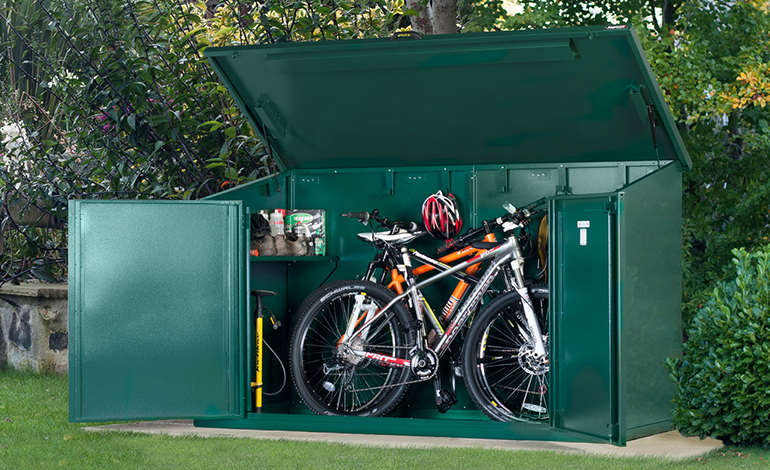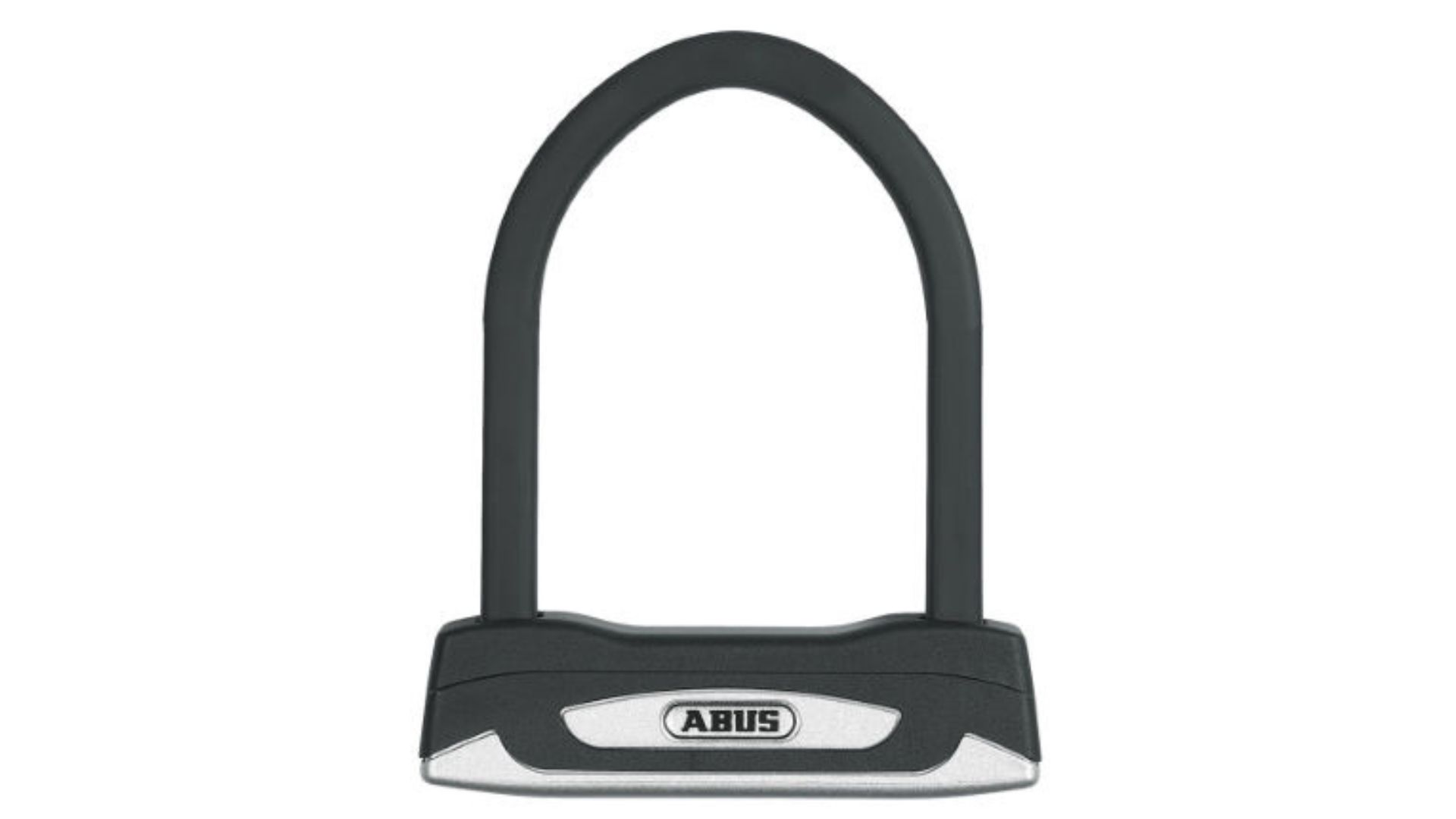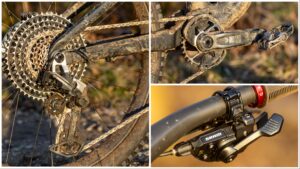If you haven't been enough to have had your bike stolen, chances are you know someone who has. And while nothing is completely theft-proof, there are plenty of things you can do to significantly reduce the risk, like using the best bike lock you can find.
The thought of your two-wheeled pride and joy disappearing off into the night is a horrifying thought, and as a result mountain bikers are security-conscious bunch. To beef up your protection and reduce the risk of theft, these are some of the best bike locks and bike security devices, plus some other practical measures you can take.

Abus Bordo Lite 6055 Folding Lock
The best portable lock for café stops
Type: Folding | Lock type: key | Rating: 9/10
Pros: Foldable, light, fits in a pocket or pack
Cons: Not the cheapest, cover around key gets scratched
This Bordo is lighter than comparable security level D-Locks, and the way it folds up on itself makes it really compact and easy to carry. I’ve been stashing it in a hip pack, but it’ll also fit in the back pocket of your jeans, or even mounted on water bottle frame bosses. The 60cm version is just long enough to secure two bikes round something thinner too.
£60 isn’t cheap, and the plastic around the key hole has scratched up a bit easily, but it’s available for much less online, and being much smaller than a D-Lock means it is really practical.
Read the full review of the Abus Bordo Lite 6055 Folding Lock

Hiplok Z Lok Cable lock
Great for deterring opportunist thieves
Type: Café lock | Lock type: No locking mechanism – pin press to release | Rating: 10/10
Pros: Lightweight and convenient to carry.
Cons: Not a replacement for a proper lock.
Ideal for deterring ‘grab it and go’ opportunist thieves when stopped for a coffee or packing your stuff away. It isn’t secure enough to be used as a proper lock however.
A simple deterrent against opportunists. Inherently the Hiplok Z Lok is ‘just’ a re-usable ziptie but what makes it different is it has an armoured core. The core is a strip of steel running the length of the tie, meaning that it takes an awful lot more effort to cut through than is required with a standard ziptie.
The Hiplok Z Lok is one of those items that as soon as you start using it will become almost indispensable.
Read the full review of the Hiplok Z Lok Cable Lock

Hiplok D1000 bike lock
The most secure bike lock
Lock type: D-lock | Security level: Diamond | Locking mechanism: keys, 3 provided
It might be heavy, but this is the highest-rated D-lock you can get, and it’s designed to be twenty times more resistant to an angle grinder attack than standard D-locks. The curved part of the lock has a square profile, and is constructed from graphene-reinforced hardened steel.
Certified for motorcycle use, this is the one to use for your expensive bikes or e-bikes.

Abus Granit X-Plus 540
Durable, strong and secure bike lock
Lock type: D-lock | Security level: Gold | Locking mechanism: Keys, key code card
Like the pricier Hiplok lock above, the Granit X-Plus from German security experts Abus has a square cross-section, which makes it more resistant to attack. This hefty lock is durable, offers a high level of protection, and has features like a retractable lock cover which will help ward off water getting in the mechanism and causing rust. It’s pricy, but then so is your bike.
One handy feature if you opt for the Abus lock ecosystem is the ability to order various locks all keyed alike, which means you can have one key to unlock them all.

Abus Ivera 7210
Best bike lock for securing bikes on racks
Lock type: Chain lock | Security level: 8/15 | Locking mechanism: Code lock
Scenario: you’ve loaded your car on your rack and are heading home after a nice ride out on your local trails. On the way, you stop at the garage or shop, head inside to pick up a few things, then come back out to see your beloved bike has disappeared from your roof or tow rack. Disaster!
While you can get some lockable racks, others aren’t as secure, and it’s not that hard – sadly – to pull a bike off a rack while the driver is distracted. If you’re planning on stopping for a bit, a chain lock is ideal for deterring would-be thieves, and this one from Abus is a great option. Note: we don’t recommend leaving the lock on while driving!
The fabric coating means the 72 metal links within aren’t going to scratch either your vehicle or your bike, and it comes with two locks. The downside is that at 7mm, those links aren’t hugely secure, so this isn’t a long-term security option.

Kryptonite New-U Evolution Standard
A great all-rounder D-lock
Lock type: D-lock | Security level: 8/10 | Locking mechanism: Keys, 3 provided including one with LED light
Kryptonite are one of the big names in bike security, and as such have a lot of experience in developing great locks at a range of price points and security levels.
This is the newest version of one of it’s most popular D-locks. You’ve almost certainly seen them on bikes locked up in towns and cities everywhere. This new model has several advantages over the old. It has a hardened double deadbolt and smaller crossbar design, which make it more resistant to attacks where the thief tries to twist the lock with a crowbar or similar so it pops open. The lock cylinder is disc-style, which makes it more resistant to lock picks and drills too.
It’s moderately heavy, comes with a bracket if you did want to attach it to your bike, and is a good blend of security, price and features.

Kryptonite Stronghold Ground Anchor
Kryptonite Stronghold Ground Anchor
Great for tying your bikes to, the Kryptonite Stronghold Anchor has a 16mm hardened carbon alloy steel shackle. Set it into concrete, but make sure it’s in the right spot because there’s no getting it out again.

Kryptonite Evolution Series Integrated Chain
Kryptonite Evolution Series Integrated Chain
Goes perfectly with the ground anchor, Kryptonite’s Evolution Series Integrated Chain hides the padlock away in the end of the chain so there’s less to attack. Comes in a range of lengths.

Pragmasis Shed Shackle
Pragmasis Shed Shackle
What about if you’ve got no concrete floor for an anchor… The Shed Shackle from Pragmasis reinforces a large area of shed wall, meaning a thief has to cut or smash out a huge section if they want the Shackle out.

Asgard Access E Plus
Asgard Access E Plus
Investing in a shed? Asgard makes some of the best, like the Access E Plus that features charging points for e-bikes (or your lights or Di2 if you’re not into e-bikes). It’s made from weatherproof steel and weighs 19 stone so there’s be no shifting it when it’s anchored to the ground.

What to look for in a bike lock
Shopping for a new bike lock and not sure what to look for? These are the main elements to consider.
Cost and security level
These two go hand in hand; the more secure your bike lock, the more expensive it is and vice versa.
In the UK, bike locks will have a ‘Sold Secure’ rating, coloured either bronze, silver or gold, with gold being the highest security rating. This is also important if you’ve got bike insurance, because some insurance companies will stipulate that a lock of a particular level should be used.
Length or size
Depending on where and how you’re planning on locking your bike up, you’ll need to consider how big or long your lock/chain is. It needs to be big enough to at least get around one tube of the frame and some kind of secure anchor.
What are the different types of bike lock?
There are lots of different types of bike lock out there. Some you’ll use alone, some in combination with each other, and some will be suitable for some environments and not others.

D-lock
D-locks, also sometimes called U-locks, are a two-piece lock without a separate padlock. In fact, think of them like one giant bike padlock, where the curved element complete detaches. These come in various sizes which allow them to fit around different sized objects to lock to.
They often come with an on-bike mounting bracket, though these are almost never used on mountain bikes as you wouldn’t want to ride with one strapped to your bike.
To use, thread the curved part of the shackle around a secure, immoveable object or piece of street furniture, then around the bike frame and, if it’s big enough, the rear wheel. Then attach the straight element and lock into place. Add more security for your wheels by also using a reinforced cable – many brands will sell these as a bundle – which threads through your wheels and through the lock.
This type of lock is great for keeping your bike locked up temporarily when popping into the shops or grabbing a coffee. You could also use it in combination with a ground anchor for a second level of security inside a garage, shed or house.

Chain lock
These are exactly what they sound like; a sturdy chain, usually covered by either plastic, rubber or fabric to stop the metal damaging the bike frame, and secured by a strong padlock or mini D-lock.
Often used by motorcyclists, these are more flexible than D-locks so are able to move and shape around a bike and the thing you’re anchoring it to. They are also often extremely heavy and bulky, so these are more useful if you want a secondary level of security inside your van, garage, shed or house, and again can work in combination with a ground anchor.

Reinforced cable
These are usually constructed from a length of steel fibre rope, wrapped in a plastic or rubber tube or coating, with a small loop at each end, through which a padlock or D-lock can be threaded.
They’re very flexible and come in a range of lengths, and are useful for threading through things like wheels if you’re looking for extra security when locking your bike up. However, they’re not as secure as a D-lock or chain, so don’t use these in isolation if you’re leaving your bike somewhere where it’s vulnerable.

A chain lock threaded through a ground anchor
Ground anchor
This is exactly what it sounds like: a strong loop or bar bolted or set into the ground (or wall). Used in conjunction with some of the other locks above, this provides an immovable anchor point for your bike where there might not be one otherwise. They’re popularly mounted on garage floors or walls.
How to lock your bike up securely
If you’re out and about and need to leave your bike for whatever reason, then make sure you lock it with at least one sturdy lock. This should thread through your frame, your rear wheel as well if the lock will reach, and around something securely anchored to the ground. Make sure the bike can’t be just lifted over the top of this; so railings or lampost are good, bollards are no good. You could add a second bike lock for added security.
No bike lock is 100% secure, so ideally if you do lock your bike up outside, leave it for as short a time as possible, somewhere that’s well lit, and ideally keep an eye on it.
At home, ideally you want to be storing your bike in the most secure location you can manage. This should be a covered area, which keeps the bike out of the elements but also hidden from prying eyes. If it’s a garage or shed, read our tips on things you can do to avoid bike theft below for how you can ensure this is as secure as possible. Within the storage area, it’s worth considering a secondary level of protection, such as a securely mounted ground anchor, then one or a combination of D-locks, chain locks or reinforced cable through the bike/s and wheels.
7 things you can do to avoid bike theft
1. Think like a thief
Unpleasant, but necessary. Spend some time looking at your shed or garage in a new light, and think about the weak points. “They don’t care about collateral damage,” says Steve Briggs, who designs top end bike locks for engineering firm Pragmasis. “We know of a case where thieves attacked six bikes that were chained together and the owner thought he didn’t need a ground anchor — the thieves hacked through five frames to get one bike out, with the chain still attached.”
Do you leave a spade next to the shed that could be a handy crowbar? Are there windows so thieves can see what’s inside? Is your garden gate old and falling off its hinges? Does the shed have secure doors and windows but a roof that’s easy to get through? Grab your virtual swag bag and probe your property for weak points.
2. Do the simple stuff: replace bolts, design for difficulty
Not all security has to mean alarm systems and complex safe-like sheds. There are plenty of things you can do to make your bike a less alluring target, by making it harder, more awkward and uncomfortable, and more time consuming for the would-be thief.
Security screws with rounded ends that secure hinges, bolts and padlocks to sheds don’t work, according to Briggs. “Thieves don’t muck about with screwdrivers, they use a crowbar and rip it all out,” Briggs says.
Replace them with long, round-headed coach bolts that secure on the inside to a bolt with a washer, with one bolt on each side of the hinge and one bolt on each side of any lock. “It doesn’t cost much to do that, but all of a sudden the thief has to work hard,” Steve says. “In terms of overall cost effectiveness things like this are the best.”
Think things like gravel paths which are noisy to walk on, spiky plants which are painful to get through, and automatic or movement-triggered security lights.
3. New locks and bolts
Simple sliding bolts with a padlock are vulnerable, so replace them with a hasp and staple — that’s the thing with a flap of metal that shuts over a ring bolt. “Get a good one. Sometimes the staple is so slim it can be cut with bolt cutters,” Briggs shares. “And make sure the staple is vertical, not horizontal, because it lets the padlock hang downwards and not stick up, inviting attack.”
Up and over garage doors are pretty puny, but if you’ve got another way in to the garage it’s easy to just put sliding bolts on the inside. If not, buy some garage locking door bolts.
What about a Garage Defender? “It’s tricky,” says Briggs. “If you’re a row of six lockups and everyone has one, get one. If you’re the only one who’ll have one, then don’t get one because it’ll advertise you have something in there. Then again, if you’ve already had a theft then get one, because they know you have valuable stuff and there’s a pretty good chance they’ll come back.”
4. Think security inside as well as out
If the thief gets inside your garage or shed, you need level two security. “You’re always looking to tie the bikes down, so get a ground anchor and chain,” Briggs says.
Locks are heavy though so make sure you invest in something you can handle, and actually use it, rather than something huge and clunky that gathers dust. “The idea is for the thief to take one look and walk away.”
Ideally use more than one type of lock (chain, D-lock etc) and secure your bikes through the frame and wheels too.
5. Don’t advertise what you’ve got
Who doesn’t love posting pictures of their bike? And while it’s gratifying to share the adulation of online friends who are as impressed with your bike as you are, others could be watching.
“Don’t advertise what you’ve got,” Briggs says. That means no bike brand stickers on the windows of your shed, car, van and so on, and don’t work on your bike on the front drive. Do what you can to make your stuff look
“If people are careless on social media thieves can tell where you live, and see what bikes you’ve got too,” according to Briggs. This means try to avoid posting anything that associates your nice bike with exactly where you live, if you can avoid it.
Also think about things like Strava, which, if you have a publicly viewable profile and you’ve added the details, means that people could see what bike you ride and where your journeys start and end. Either make your profile private, don’t post what bike you have and set up a zone around your start point that will obscure where you live.
So should you shout about how much security you have? Yes and no, Steve says. You don’t want it to draw people in so it needs to be unobtrusive from a distance. “But it needs to be bloody secure and obviously so, if someone’s close up and in your garden looking around.”
6. Join a bike registration organisation
If you’re in the UK, the national, police approved registration scheme is called Bike Register. It’s free to join and has close to one millions registrations. You’ll receive a free sticker to add to your bike to deter thieves.
If your bike is stolen, you can report it online and share details via social media.
7. Remove accessories
Always remove things like lights, bags and other valuable attachments that would be easy for a thief to remove and sell. While not as valuable a full bike, those 200 quid Exposure lights or fancy bikepacking frame bag are expensive to replace.
This also means components. Designer saddles and front wheels are prime targets, especially if they’re pricy and high quality.
















